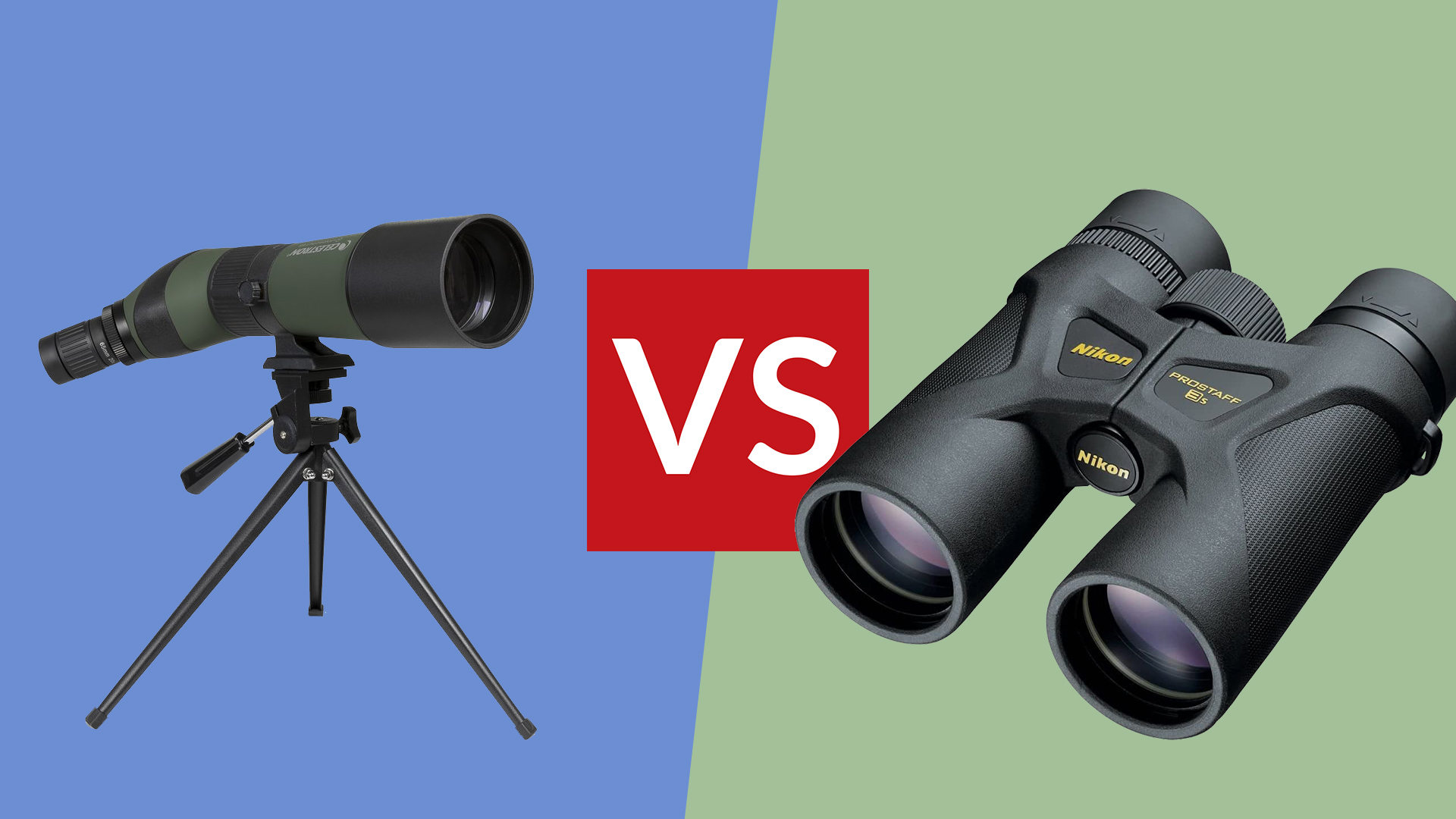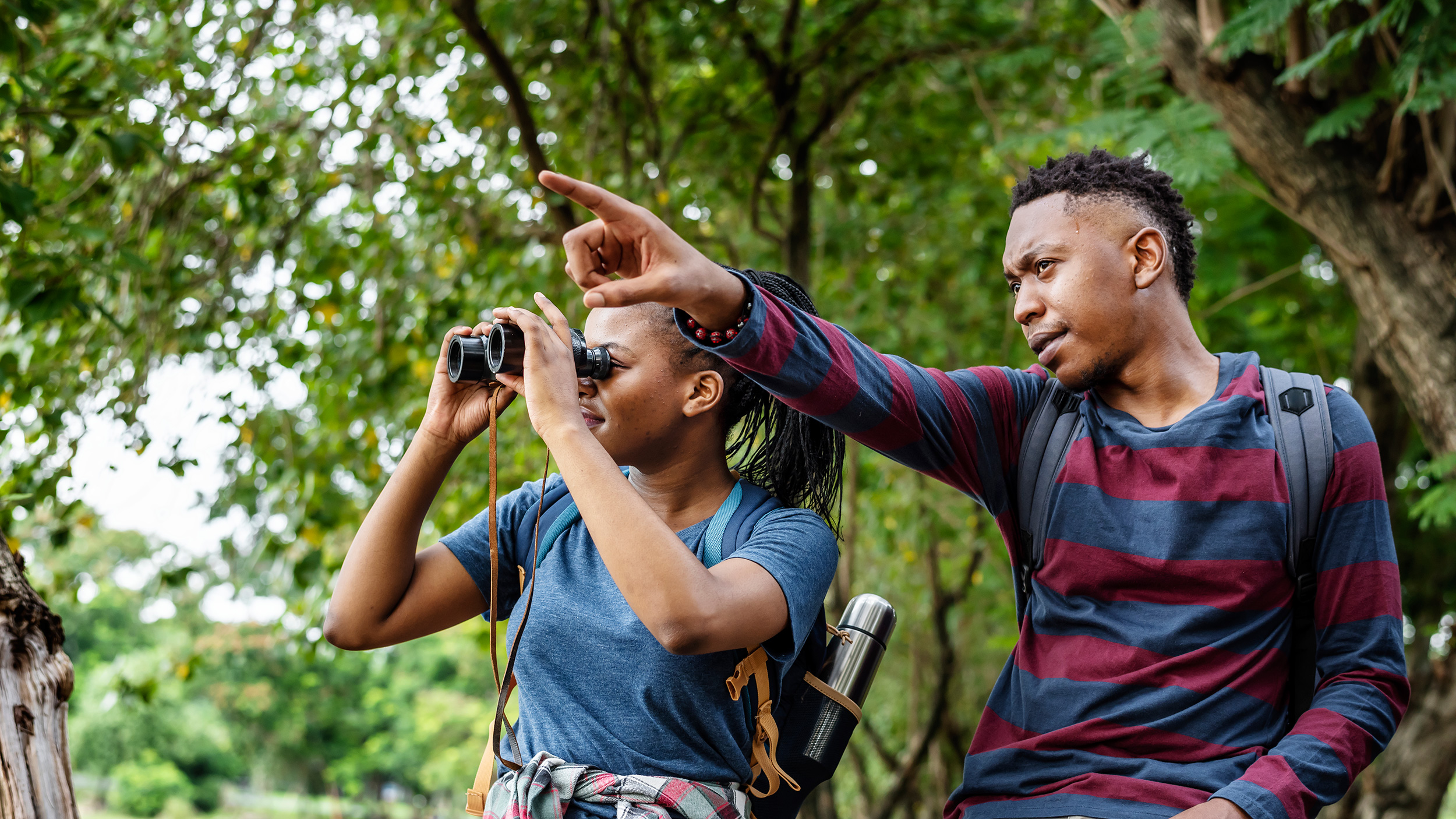Binoculars vs spotting scopes: which one is right for your needs?
Though broadly offering similar functions, what advantage does a spotting scope have over a pair of binoculars, and vice versa? We drill into the key advantages and features of both


While it may be a specialist tool compared to a regular pair of binoculars, the spotting scope has much to recommend it for those who want to bring faraway subjects – including even the moon – that much closer. A spotting scope provides a step up from many of the best binoculars in that it grants us greater magnification. This means it's particularly suited to bird watching or in fact anything to do with nature or wildlife, where getting any closer than the scope allows will potentially scare off our visual quarry.
Bear in mind though, that unlike all but the largest binoculars, most spotting scopes are designed for use with a tripod of some sorts, whether a compact fold-up travel tripod or something altogether larger, in order to provide the best in viewing stability. A steady image also allows users to explore the art of 'digiscoping', namely the attachment of a camera to our scope, in order to not just get up close to a faraway subject, but also record the moment via the taking of stills or video. However, in being more portable and offering a wider field of view, a pair of binoculars still has much to recommend it. So which is best? Well, it all depends… read on for our binoculars vs spotting scopes explainer.
If you're hoping to use your new purchase to gaze deep into space, there's a third option, of course: invest in one of the best telescopes. Our telescopes vs binoculars for stargazing explainer will help you make a decision there.
Binoculars vs spotting scopes: pros and cons
The major practical difference between a spotting scope and a pair of binoculars is that the spotting scope is constructed for use with one eye, just like a monocular, while binoculars are designed for use with two.
And, as mentioned in our intro, because of the greater magnification offered by a spotting scope, generally a tripod is a must in order that a stable, judder-free image can be achieved, especially at maximum magnification. By contrast, all but the most high-specified and expensive binos don't generally require a tripod to use, though larger models may well come with their own tripod adapter or screw-thread.
Generally speaking, it follows that a pair of binoculars makes for a more portable viewing tool than a spotting scope. Even if the magnification offered and the size of the lens can't always compete with a spotting scope, binos will satisfy the demands of most casual observers.

There are a couple of different construction types to bear in mind it comes to spotting scopes: namely either an angled or straight body. As the latter suggests, the body and the eyepiece of the scope lie on the same optical plane, allowing the user to look straight through the eyepiece at the intended subject. By contrast, in an angled body spotting scope the eyepiece is situated at 45 degrees to the body, meaning the user's line of sight is also at an angle. The benefit of this second type of second type of scope allows for more comfortable use when lying or sitting and saves the need to crane our necks, no matter what height we are.
As we've noted in other comparisons, because binoculars are more of a mass market tool, more companies are involved in manufacture, so there is likely to be a greater choice of options, at a competitively wide array of prices. Like anything, of course your purchase decision will be influenced not just by specification and performance, but also by intended budget.
Binoculars vs spotting scopes: which would suit you?
If staying light and agile is key, especially if heading out on our travels or sight-seeing, then for the reasons given above a pair of binoculars we can hand hold makes for a sound choice. A spotting scope is more of a specialist device, additionally requiring a tripod in most cases, therefore making it less practical if we're going to be moving about a lot.
So, if we're not sure what we'll encounter in terms of conditions and subject matter, and are looking for a jack-of-all trades tool for whatever observational opportunities life may throw at us, then the versatility of the binocular is king. But if we're confident we'll need that additional magnification in advance, say for observing skittish wildlife or even gazing heavenwards on occasion, then a spotting scope is the clear alternative choice, as a step up from binos.

As we noted in our intro, some spotting scopes, particularly those manufactured by specialist photo brands including Nikon, are designed to work with cameras, sometimes requiring an adapter to do so, which increases their versatility in allowing pictures to be taken of wildlife that would otherwise be scared away if moving closer. The spotting scope is often a fair bit cheaper than buying a dedicated telephoto lens offering anywhere near an equivalent zoom for our camera.
Another factor worth noting is that binoculars offer the user a wide field of view, so we can see more of our surroundings, whereas, due to the fact that spotting scopes offer higher magnification, they have a smaller field of view.
Of course, as it's once again a case of 'horses for courses', there is nothing stopping any of us hunting down and investing in a binocular plus a spotting scope too. We then have the ability to select whichever is the best fit as an observation tool to cope with the circumstances before us.
Binoculars vs spotting scopes: features to look for
Yes, binos and spotting scopes serve similar functions. But when it comes to the numbers to pay attention to, the two differ. With binoculars there are two key numbers on the spec list: the magnification offered and the size of the objective lens, given as, to take one example, 10x42.
With a spotting scope there are three numbers to consider. The first two numbers given for a spotting scope indicate the magnification range, for example 14-45, while the latter indicates the size of the front lens, say '60' to indicate a 60mm lens. So, just like with binoculars there is – forgive the pun – plenty of 'scope' when it comes to spotting scopes.
For both, the greater the magnification the farther we'll be able to see, while the larger the objective lens the more light will be let in, giving us a brighter and more sharply defined image. Do take into account though that the larger the numbers given in the specification are, the physically bigger the binos or spotting scope will be, and inevitably the higher the price tag. Other important features to look for include nitrogen purged housing or casing, which prevents fogging when used in the cold and the wet. When it comes to spotting scopes, some also offer the chance to swap out the eyepiece they're provided with – on such models, for this reason, the eyepiece itself is sometimes an 'extra' – which allows for magnification to be adjusted to best suit the subject under observation.
Overall, though, the inevitable conclusion is that for convenience and portability, as well as broadly being more affordable, the binocular is the clear winner. But for those occasions when we need a significant magnification factor, or a bigger objective lens to improve the quality of our image, while observing subjects from a fairly static position, the spotting scope comes up trumps. For this reason serious wildlife watchers will swear by the 'scope.
Get all the latest news, reviews, deals and buying guides on gorgeous tech, home and active products from the T3 experts

Gavin Stoker has been writing about photography and technology for the past 20 years. He currently edits the trade magazine British Photographic Industry News - BPI News for short - which is a member of TIPA, the international Technical Imaging Press Association.